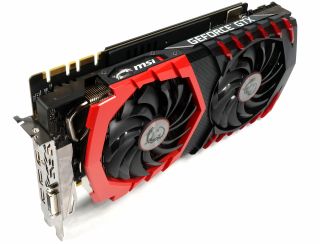MSI GeForce GTX 1080 Ti Gaming X 11G Review
Why you can trust Tom's Hardware
Final Analysis
Nvidia's GeForce GTX 1080 Ti is the second-fastest single-GPU graphics card you can buy, and only because there's a $1200 Titan Xp offering questionable value out there, too. MSI's implementation of the 1080 Ti comes close to perfection by offering improved performance and quiet operation. The GeForce GTX 1080 Ti Gaming X 11G's factory settings nearly achieve an ideal compromise for most customers. But it also boasts some thermal and electrical reserves that allow enthusiasts to explore the card's peak potential (at the expense of some of its finesse).

Our sample was able to maintain 2050 MHz. Of course, that required adjusting MSI's fan curve, causing the card to get noticeably louder. Our journey above 2 GHz was helped by the option to go from a ~290W power target up to 330W using MSI's software. That's plenty of headroom to experiment with. From there, you'll find cooling and cooling alone determines where GPU Boost steps in and draws the line.
The only flaw worth mentioning is the positioning of the memory's power supply, which MSI cools with a plate. The excess heat produced there does affect the three neighboring memory modules in particular. Thus, you probably don't want a case with restricted airflow since 300W of power consumption translates to a lot of extra heat that needs to be exhausted.
With that said, aggressive overclocking with a higher power target calls for a case armed with high-quality fans. A full-tower enclosure might help as well. And it goes without saying that this isn't a card you want to wedge into a small form factor chassis. MSI's GeForce GTX 1080 Ti Gaming X 11G wants to breathe plenty of fresh air.
MORE: Best Graphics Cards
MORE: Desktop GPU Performance Hierarchy Table
MORE: All Graphics Content
Stay on the Cutting Edge
Join the experts who read Tom's Hardware for the inside track on enthusiast PC tech news — and have for over 25 years. We'll send breaking news and in-depth reviews of CPUs, GPUs, AI, maker hardware and more straight to your inbox.
-
Scorpionking20 Thanks. I would love a database of clocks/temps/noise comparing differing cards. I'm looking to sidegrade my 1070's to a 1080ti, and am not in a rush. Noise bugs me a lot more than others, so I try to go for the most quiet solution...but I may be getting a Ryzen with a proper loop too, so if I did that I may get a FE card to throw into the loop...too many options.Reply -
FormatC I've already tested four cards in Germany (four more in pipeline), all other stuff is already in translation. After publishing a few more cards on US site, we will put also a kind of landing/summary page with comparable data ;)Reply
But I can't spoiler the other reviews results before publishing it ;) -
zthomas Sound and temp is it increased with this card? .. with its own cooler how much cooler? Lots of fans pushing air.. yeah I updated my case.. has three large fans.. one thing i don't get.. I have seen nothing of temperature controls, no meters nothing to indicate temperatures inside the case.. or nothing showing use a peak times during gaming..Reply -
FormatC I can't understand your question, sorry.Reply
But you can monitor the GPU temperature by yourself with tools like GPU-Z or MSI Afterburner (also with an OSD). Then compare the results with my IR pictures and you have a good point to calculate the other temps by yourself. ;) -
FormatC The problem is:Reply
Nvidia has never sampled this card.
I have here a Quadro P6000 and this card is similar. Due the thermal limits of Nvidias stock cooler it is not significant faster. Ok, a little bit, but not a whole universe. And Nvidia will not be amused, if I use a 5000 USD workstation card in gaming benchmarks ;) -
LwNickV I have a question about Overclocking, you mention you need to "max out the voltage slider". But i saw it mentioned in another review that Voltage Slider is locked for this card. So what do you mean with that statement? Is just upping the Power Target to 330 enough to reach 2000 mhz+-?Reply -
Sam Hain Reply19669306 said:I have a question about Overclocking, you mention you need to "max out the voltage slider". But i saw it mentioned in another review that Voltage Slider is locked for this card. So what do you mean with that statement? Is just upping the Power Target to 330 enough to reach 2000 mhz+-?
Tom's was given an unlocked version of MSI AB back in March to test an FE Ti with it and was done using H20 cooling; http://www.tomshardware.com/reviews/geforce-gtx-1080-ti-water-cooling,4975-2.html They also give instructions on how to manipulate AB to access the voltage settings, until a new(er), unlocked version of AB rolls...
"We're fortunate enough to have a version of MSI’s Afterburner utility unlocked especially for us. If you want access to similar settings before a new version of Afterburner is released, you can manually add your 1080 Ti to the third-party database using the VDDC_Generic_Detection entry under the VEN_10DE&DEV_1B06&SUBSYS_120F10DE&REV_?? key. A quick search online should turn up plenty of in-depth instructions on how to do this."
However, you can just move the POWER-LIMIT slider to the max, along with bumping your clock settings. These aftermarket cards will crack past 2K MHz, no problem w/out touching voltage, this card included... It's a CHAMP!
